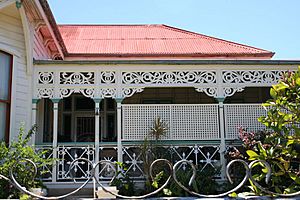Kardinia, Townsville facts for kids
Quick facts for kids Kardinia, North Ward |
|
|---|---|

Kardinia, 2006
|
|
| Location | 11 Victoria Street, North Ward, City of Townsville, Queensland, Australia |
| Design period | 1870s - 1890s (late 19th century) |
| Built | 1880s |
| Official name: Kardinia, Japanese Consulate | |
| Type | state heritage (landscape, built) |
| Designated | 21 October 1992 |
| Reference no. | 600938 |
| Significant period | 1880, 1910s (fabric) 1880s-1900s (historical) |
| Significant components | service wing, residential accommodation - main house, garden/grounds, dining room, fence/wall - perimeter |
| Lua error in Module:Location_map at line 420: attempt to index field 'wikibase' (a nil value). | |
Kardinia is a beautiful old house in North Ward, Townsville, Queensland, Australia. It was built a long time ago, in the 1880s. This special house is also known as the Japanese Consulate because it once served as Australia's very first Japanese consulate. It's so important that it's now listed on the Queensland Heritage Register, which means it's protected for future generations to enjoy.
Contents
A Look Back in Time
Kardinia is a fancy timber house built during a busy time in the 1880s. The land was first bought in 1883 by Arthur Walters. Later that year, it was sold to Edward Bevan. He was a surveyor and also edited a local newspaper.
We don't know for sure who built the first part of the house. But it seems the original building was quite small, with only two rooms. It was later made much bigger. In 1888, the house was bought by John Graham MacDonald. He was a famous explorer and a police magistrate in Townsville. A police magistrate was like a judge who handled local legal matters.
Macdonald lived at Kardinia from about 1888 to 1895. From 1896 to 1908, he rented the house to the Japanese Government. This is why it became Australia's first Japanese consulate. A consulate is like a small embassy that helps people from its country who are living or visiting another country. It also helps with trade. The consulate helped the many Japanese people living in North Queensland at that time.
After the consulate moved to Sydney in 1908, a well-known Townsville businessman named John Newport Parkes lived there. He was also the mayor of Townsville. Around this time, the name "Kardinia" first appeared for the house. In 1911, the Green family bought the house. They were very important in the newspaper business in North Queensland. A famous journalist and author, Edmund James Banfield, often visited the house because he was a good friend of the Green family. Kardinia stayed with the Green family until 1984.
What Kardinia Looks Like
Kardinia is a large timber house built high up on brick piers. It sits on top of Stanton Hill, giving it a great view of Townsville's city centre. Some of its outside walls show the timber frame, while others are covered. The roof is made of corrugated iron and has a gabled shape.
The house has a very interesting and unusual shape. It's not perfectly balanced on both sides, which is called "asymmetrical." This design shows that it was extended five times over the years. Inside, there's a long central hallway with big rooms opening off it. Many rooms have french doors that lead out to the verandah. These doors have beautiful etched glass and fancy wooden patterns above them.
The verandah has a special cast-iron fence, which is rare to find in North Queensland. A detailed wooden decoration, called a frieze, runs all along the verandah. Old timber venetian blinds are still there, providing shade and privacy. Parts of the back verandah were later closed in to create more rooms and a bathroom. The service area, which once had a maid's room and kitchen, was changed into a bigger kitchen. A large dining room was also added in 1912. The windows in this area have unusual painted glass.
Why Kardinia is Special
Kardinia was added to the Queensland Heritage Register in 1992 because it meets several important rules.
A Piece of Queensland's Story
Kardinia, built in the 1880s, is important for many reasons. It shows us how Queensland's history unfolded. As Australia's first Japanese consulate, it played a part in important trade and diplomatic dealings between Australia and Japan. It also highlights the strong connection between Japanese people moving to North Queensland in the late 1800s and early 1900s.
A Rare Design
This house is quite unique because of its unbalanced, or "asymmetrical," front design. This kind of house design was very rare until after the 1890s. So, Kardinia stands out as an unusual example of old Queensland homes.
A Great Example of Old Houses
Kardinia is a wonderful example of the fancy timber houses built in Townsville during the late 1800s. It shows us what these important homes looked like.
Beautiful and Important
Kardinia is considered beautiful and has a lot of historical and architectural value. It's also important to the community.
Connected to Important People
The house has strong links to several important people in Townsville's history. These include police magistrate John Graham Macdonald and newspaper editor David Green. It's also important for its connection to the Japanese government, which set up consular services for its people living in North Queensland.


